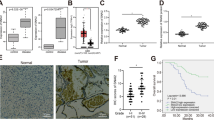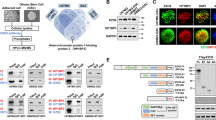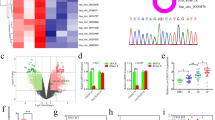Abstract
Glioma is a primary brain tumor with limited treatment approaches and glioblastoma stem cells (GSCs) are manifested with the self-renewal capability and high tumorigenic capacity. This study was performed to investigate the regulatory effect of the SUMO-specific protease 1 (SENP1)/methyltransferase-like 3 (METTL3)/MYC axis on the self-renewal of GSCs mediated by transcription factor Yin Yang 1 (YY1). Following bioinformatics analysis and clinical and cellular experiments, we found that YY1 was highly expressed in GBM tissues and cells, while silencing its expression reduced the self-renewal ability of GSCs. Functionally, YY1 promoted the transcriptional expression of SENP1 by binding to the promoter region of SENP1, while the deSUMOase SENP1 facilitated the methylase activity of m6A through deSUMOylation of the methylase METTL3, thereby promoting the m6A modification of MYC mRNA via METL3 and promoting the expression of MYC. A nude mouse xenograft model of GBM was also constructed to examine the tumorigenicity of GSCs. The obtained findings demonstrated that YY1 promoted tumorigenicity of GSCs by promoting the expression of MYC in vivo. Conclusively, YY1 can transcriptionally upregulate the SUMOylase SENP1 and enhance the methylase activity of METTL3, resulting in the increased m6A modification level of MYC mRNA, thereby promoting the self-renewal of GSCs.
This is a preview of subscription content, access via your institution
Access options
Subscribe to this journal
Receive 12 print issues and online access
$259.00 per year
only $21.58 per issue
Buy this article
- Purchase on Springer Link
- Instant access to full article PDF
Prices may be subject to local taxes which are calculated during checkout







Similar content being viewed by others
Data availability
The datasets generated and/or analyzed during the current study are available from the corresponding author on reasonable request.
References
McKinnon C, Nandhabalan M, Murray SA, Plaha P. Glioblastoma: clinical presentation, diagnosis, and management. BMJ. 2021;374:n1560.
Han B, Meng X, Wu P, Li Z, Li S, Zhang Y, et al. ATRX/EZH2 complex epigenetically regulates FADD/PARP1 axis, contributing to TMZ resistance in glioma. Theranostics. 2020;10:3351–65.
Luo C, Song K, Wu S, Hameed NUF, Kudulaiti N, Xu H, et al. The prognosis of glioblastoma: a large, multifactorial study. Br J Neurosurg. 2021;35:555–61.
Chavda V, Patel V, Yadav D, Shah J, Patel S, Jin JO. Therapeutics and research related to glioblastoma: advancements and future targets. Curr Drug Metab. 2020;21:186–98.
Yang L, Shi P, Zhao G, Xu J, Peng W, Zhang J, et al. Targeting cancer stem cell pathways for cancer therapy. Signal Transduct Target Ther. 2020;5:8.
Pedersen H, Anne Adanma Obara E, Elbaek KJ, Vitting-Serup K, Hamerlik P. Replication Protein A (RPA) Mediates radio-resistance of glioblastoma cancer stem-like cells. Int J Mol Sci. 2020;21:1588.
Jeong HY, Kim HJ, Kim CE, Lee S, Choi MC, Kim SH. High expression of RFX4 is associated with tumor progression and poor prognosis in patients with glioblastoma. Int J Neurosci. 2021;131:7–14.
Lathia JD, Mack SC, Mulkearns-Hubert EE, Valentim CL, Rich JN. Cancer stem cells in glioblastoma. Genes Dev. 2015;29:1203–17.
Gimple RC, Bhargava S, Dixit D, Rich JN. Glioblastoma stem cells: lessons from the tumor hierarchy in a lethal cancer. Genes Dev. 2019;33:591–609.
Biserova K, Jakovlevs A, Uljanovs R, Strumfa I. Cancer stem cells: significance in origin, pathogenesis and treatment of glioblastoma. Cells. 2021;10:621.
Qiu Z, Zhao L, Shen JZ, Liang Z, Wu Q, Yang K, et al. Transcription elongation machinery is a druggable dependency and potentiates immunotherapy in glioblastoma stem cells. Cancer Discov. 2022;12:502–21.
Wang Z, Sun D, Chen YJ, Xie X, Shi Y, Tabar V, et al. Cell lineage-based stratification for glioblastoma. Cancer Cell. 2020;38:366–79. e8
Kaufhold S, Garban H, Bonavida B. Yin Yang 1 is associated with cancer stem cell transcription factors (SOX2, OCT4, BMI1) and clinical implication. J Exp Clin Cancer Res. 2016;35:84.
Baritaki S, Chatzinikola AM, Vakis AF, Soulitzis N, Karabetsos DA, Neonakis I, et al. YY1 Over-expression in human brain gliomas and meningiomas correlates with TGF-beta1, IGF-1 and FGF-2 mRNA levels. Cancer Invest. 2009;27:184–92.
Chen L, Gong X, Huang M. YY1-activated long noncoding RNA SNHG5 promotes glioblastoma cell proliferation through p38/MAPK signaling pathway. Cancer Biother Radiopharm. 2019;34:589–96.
Waters MR, Gupta AS, Mockenhaupt K, Brown LN, Biswas DD, Kordula T. RelB acts as a molecular switch driving chronic inflammation in glioblastoma multiforme. Oncogenesis. 2019;8:37.
Xia W, Tian H, Cai X, Kong H, Fu W, Xing W, et al. Inhibition of SUMO-specific protease 1 induces apoptosis of astroglioma cells by regulating NF-kappaB/Akt pathways. Gene. 2016;595:175–9.
Wu T, Donohoe ME. Yy1 regulates Senp1 contributing to AMPA receptor GluR1 expression following neuronal depolarization. J Biomed Sci. 2019;26:79.
Li X, Meng Y. SUMOylation regulator-related molecules can be used as prognostic biomarkers for glioblastoma. Front Cell Dev Biol. 2021;9:658856.
Zhang QS, Zhang M, Huang XJ, Liu XJ, Li WP. Downregulation of SENP1 inhibits cell proliferation, migration and promotes apoptosis in human glioma cells. Oncol Lett. 2016;12:217–21.
Xiang-Ming Y, Zhi-Qiang X, Ting Z, Jian W, Jian P, Li-Qun Y, et al. SENP1 regulates cell migration and invasion in neuroblastoma. Biotechnol Appl Biochem. 2016;63:435–40.
Dong Z, Cui H. The emerging roles of RNA modifications in glioblastoma. Cancers (Basel). 2020;12:736.
Li F, Yi Y, Miao Y, Long W, Long T, Chen S, et al. N(6)-methyladenosine modulates nonsense-mediated mRNA decay in human glioblastoma. Cancer Res. 2019;79:5785–98.
Cui Q, Shi H, Ye P, Li L, Qu Q, Sun G, et al. m(6)A RNA methylation regulates the self-renewal and tumorigenesis of glioblastoma stem cells. Cell Rep. 2017;18:2622–34.
Visvanathan A, Patil V, Arora A, Hegde AS, Arivazhagan A, Santosh V, et al. Essential role of METTL3-mediated m(6)A modification in glioma stem-like cells maintenance and radioresistance. Oncogene. 2018;37:522–33.
Shi J, Chen G, Dong X, Li H, Li S, Cheng S, et al. METTL3 promotes the resistance of glioma to temozolomide via increasing MGMT and ANPG in a m(6)A dependent manner. Front Oncol. 2021;11:702983.
Tassinari V, Cesarini V, Tomaselli S, Ianniello Z, Silvestris DA, Ginistrelli LC, et al. ADAR1 is a new target of METTL3 and plays a pro-oncogenic role in glioblastoma by an editing-independent mechanism. Genome Biol. 2021;22:51.
Xu P, Ge R. Roles and drug development of METTL3 (methyltransferase-like 3) in anti-tumor therapy. Eur J Med Chem. 2022;230:114118.
Cheng M, Sheng L, Gao Q, Xiong Q, Zhang H, Wu M, et al. The m(6)A methyltransferase METTL3 promotes bladder cancer progression via AFF4/NF-kappaB/MYC signaling network. Oncogene. 2019;38:3667–80.
Zhang C, Zhi WI, Lu H, Samanta D, Chen I, Gabrielson E, et al. Hypoxia-inducible factors regulate pluripotency factor expression by ZNF217- and ALKBH5-mediated modulation of RNA methylation in breast cancer cells. Oncotarget. 2016;7:64527–42.
Yang DD, Chen ZH, Yu K, Lu JH, Wu QN, Wang Y, et al. METTL3 promotes the progression of gastric cancer via targeting the MYC pathway. Front Oncol. 2020;10:115.
Du Y, Hou G, Zhang H, Dou J, He J, Guo Y, et al. SUMOylation of the m6A-RNA methyltransferase METTL3 modulates its function. Nucleic Acids Res. 2018;46:5195–208.
Yu J, Zhang SS, Saito K, Williams S, Arimura Y, Ma Y, et al. PTEN regulation by Akt-EGR1-ARF-PTEN axis. EMBO J. 2009;28:21–33.
Li Q, Uemura Y, Kawahara Y. Cross-linking and immunoprecipitation of nuclear RNA-binding proteins. Methods Mol Biol. 2015;1262:247–63.
Tabatabai G, Weller M. Glioblastoma stem cells. Cell Tissue Res. 2011;343:459–65.
Sharifzad F, Ghavami S, Verdi J, Mardpour S, Mollapour Sisakht M, Azizi Z, et al. Glioblastoma cancer stem cell biology: Potential theranostic targets. Drug Resist Updat. 2019;42:35–45.
Li H, Li T, Huang D, Zhang P. Long noncoding RNA SNHG17 induced by YY1 facilitates the glioma progression through targeting miR-506-3p/CTNNB1 axis to activate Wnt/beta-catenin signaling pathway. Cancer Cell Int. 2020;20:29.
Wang Q, Zheng D, Li Y, Zhang Y, Sui R, Chen Y, et al. Circular RNA circ_0001588 sponges miR-211-5p to facilitate the progression of glioblastoma via up-regulating YY1 expression. J Gene Med. 2021;23:e3371.
Katsushima K, Natsume A, Ohka F, Shinjo K, Hatanaka A, Ichimura N, et al. Targeting the Notch-regulated non-coding RNA TUG1 for glioma treatment. Nat Commun. 2016;7:13616.
Cui CP, Wong CC, Kai AK, Ho DW, Lau EY, Tsui YM, et al. SENP1 promotes hypoxia-induced cancer stemness by HIF-1alpha deSUMOylation and SENP1/HIF-1alpha positive feedback loop. Gut. 2017;66:2149–59.
Han J, Wang JZ, Yang X, Yu H, Zhou R, Lu HC, et al. METTL3 promote tumor proliferation of bladder cancer by accelerating pri-miR221/222 maturation in m6A-dependent manner. Mol Cancer. 2019;18:110.
Guo J, Xiang Q, Xin Y, Huang Y, Zou G, Liu T. miR-544 promotes maturity and antioxidation of stem cell-derived endothelial like cells by regulating the YY1/TET2 signalling axis. Cell Commun Signal. 2020;18:35.
Varum S, Baggiolini A, Zurkirchen L, Atak ZK, Cantu C, Marzorati E, et al. Yin Yang 1 orchestrates a metabolic program required for both neural crest development and melanoma formation. Cell Stem Cell. 2019;24:637–53. e9
Lu Z, Hong CC, Kong G, Assumpcao A, Ong IM, Bresnick EH, et al. Polycomb group protein YY1 is an essential regulator of hematopoietic stem cell quiescence. Cell Rep. 2018;22:1545–59.
Wang J, Wu X, Wei C, Huang X, Ma Q, Huang X, et al. YY1 positively regulates transcription by targeting promoters and super-enhancers through the BAF complex in embryonic stem cells. Stem Cell Rep. 2018;10:1324–39.
Yoshida GJ. Correction to: Emerging roles of Myc in stem cell biology and novel tumor therapies. J Exp Clin Cancer Res. 2018;37:285.
Varlakhanova NV, Cotterman RF, deVries WN, Morgan J, Donahue LR, Murray S, et al. myc maintains embryonic stem cell pluripotency and self-renewal. Differentiation. 2010;80:9–19.
Cai C, Hu X, Dai P, Zhang T, Jiang M, Wang L, et al. c-Myc regulates neural stem cell quiescence and activation by coordinating the cell cycle and mitochondrial remodeling. Signal Transduct Target Ther. 2021;6:306.
Dong J, Huang Q. Targeting glioma stem cells: enough to terminate gliomagenesis? Chin Med J (Engl). 2011;124:2756–63.
Funding
This study was supported by the Sichuan Clinical Research Center for Neurosurgery, Luzhou Science and Technology Program (2020-JYJ-45), Science and Technology Foundation of Sichuan (2021YJ0430) and Luzhou Municipal People’s Government-Southwest Medical University Joint Project (2020LZXNYDJ33).
Author information
Authors and Affiliations
Contributions
Conceived and designed the experiments: XBY, BT, and LLP. Performed experiments: YJ, HPH, and SZ. Performed experimental validation: JZH and LGC. Analyzed the data and conceived figures: XGX and CHZ. Wrote the manuscript: XBY, BT, and LLP. Revised the manuscript: YJ, TMP, and CHZ. All authors approved the final version of the manuscript.
Corresponding authors
Ethics declarations
Competing interests
The authors declare no competing interests.
Additional information
Publisher’s note Springer Nature remains neutral with regard to jurisdictional claims in published maps and institutional affiliations.
Supplementary information
Rights and permissions
Springer Nature or its licensor (e.g. a society or other partner) holds exclusive rights to this article under a publishing agreement with the author(s) or other rightsholder(s); author self-archiving of the accepted manuscript version of this article is solely governed by the terms of such publishing agreement and applicable law.
About this article
Cite this article
You, J., Tao, B., Peng, L. et al. Transcription factor YY1 mediates self-renewal of glioblastoma stem cells through regulation of the SENP1/METTL3/MYC axis. Cancer Gene Ther 30, 683–693 (2023). https://doi.org/10.1038/s41417-022-00580-0
Received:
Revised:
Accepted:
Published:
Issue Date:
DOI: https://doi.org/10.1038/s41417-022-00580-0



